Background
- Nowadays, fossil-based power generation dominates the market.
- Extraction and burning of coal, oil and gas are linked to increasing CO2 emissions and significantly contribute to climate change (Owusu & Asumadu-Sarkodie 2016).
- Global energy demand is forecasted to grow by approximately 27% (3,743 million tons in oil equivalent) by 2040 (Eule 2018).
A vast majority of humans’ daily activities require the use of energy. Healthcare, communication, mobility, and many other functions and services aimed to meet even the most basic human needs cannot be performed and rendered without a secure supply of energy. Thus, the energy sector is booming nowadays, whereas the fossil-based power generation dominates the market. Nevertheless, it is not a secret that extraction and burning of coal, oil and gas are associated with carbon dioxide (CO2) emissions and, thus, significantly contribute to climate change (Owusu & Asumadu-Sarkodie 2016). The adverse environmental impacts of fossil extraction and consumption may intensify as global energy demand is forecasted to grow by approximately 27% or 3,743 million tons in oil equivalent from 2017 to 2040 (Eule 2018). Clearly, it will be impossible to maintain energy security and environmental sustainability by continuing to exploit non-renewable energy sources further. Considering this, a shift towards alternative energy seems to be a good solution.
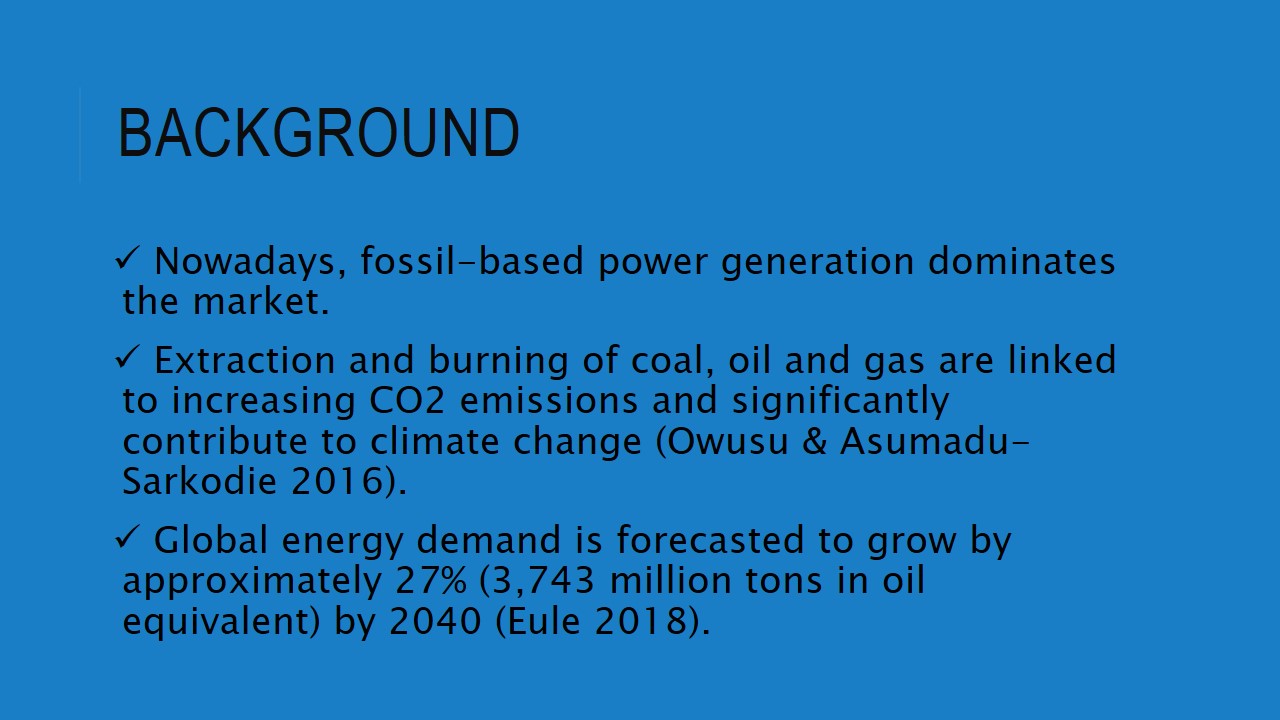
Alternative Energy: Definition
The concept of alternative energy includes energy sources other than fossil fuels (Taylor n.d.).
The term “alternative energy” refers to energy sources other than fossil fuels, including renewable sources, such as solar and wind energy, as well as nuclear energy (Taylor n.d.). It is important to make a distinction between nuclear energy and other types of alternative energy sources since the former one is generated by using the mined natural elements and is not renewable. Considering the differences between the two and inherent hazards of nuclear power generation, the focus in this presentation will be made primarily on renewable energy sources.
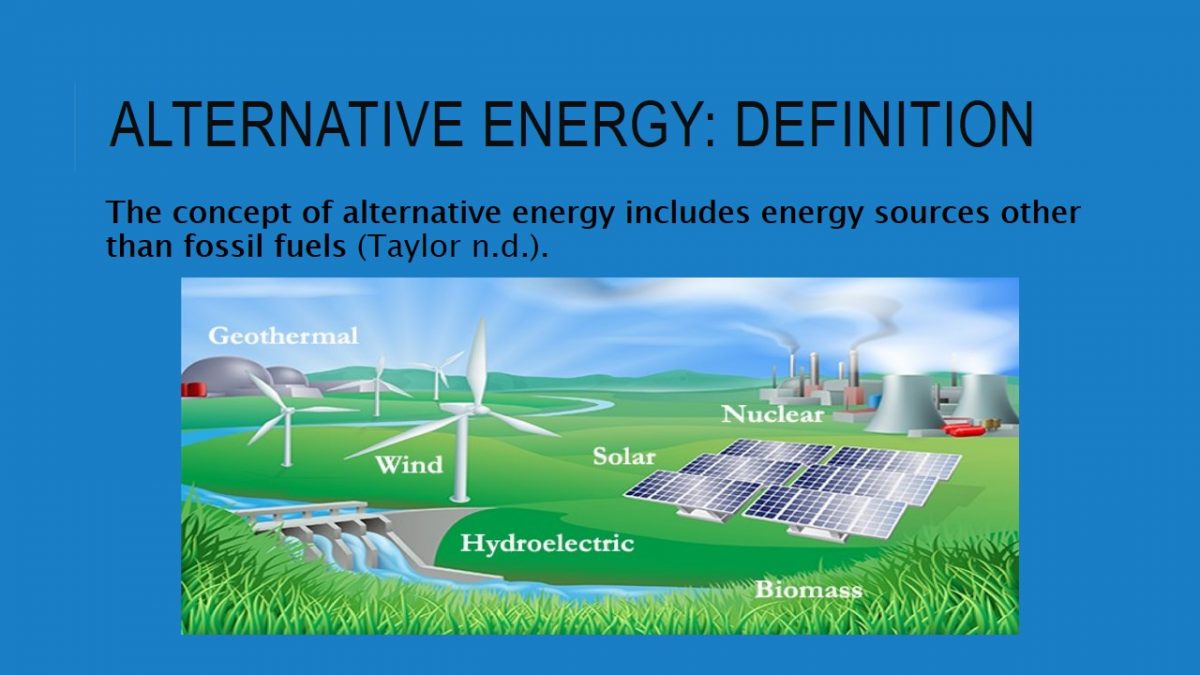
Thesis Statement
Even though alternative energy production will not allow solving all of the existing environmental concerns, the shift towards a universal use of alternative energy will have a significant positive environmental impact mainly because power plants utilising renewable sources are associated with lower levels of CO2 emissions, as well as soil and water contamination and waste.
The shift towards alternative energy will have a positive environmental impact mainly because power plants utilising renewable sources produce a lesser amount of CO2 emissions compared to fossil-based power plants (Vezmar et al. 2014). In addition, renewable energy production is potentially less detrimental in terms of water safety compared to other plants that run on coal and other fossils and can be associated with a lower level of soil and water contamination (Tripathi et al. 2015). Nevertheless, it is valid to say that the use of alternative energy sources will not resolve all present environmental concerns. In this presentation, I will outline some of the major controversies linked to possible environmental impacts of renewable energy.
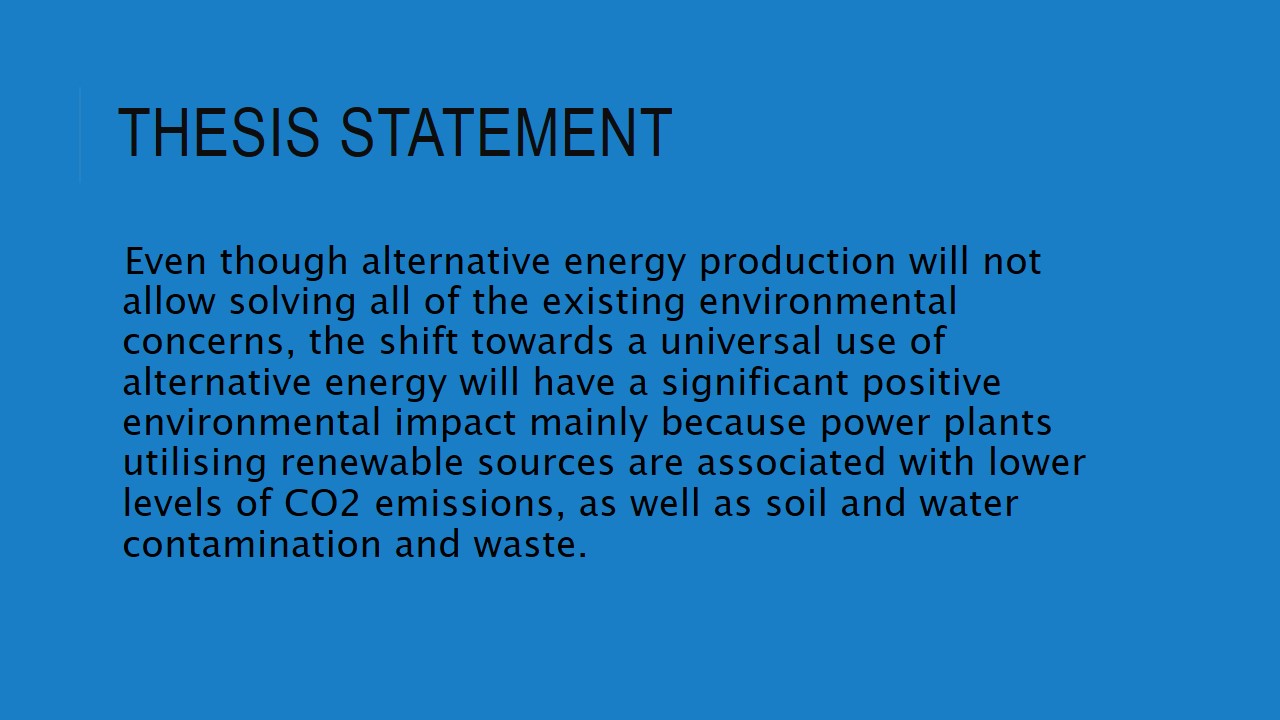
Argument 1: Renewable energy use will help to curb global co2 emissions
The graph created by Vezmar et al. (2014) demonstrates that all plants generating energy by using renewable sources produce by far a lesser amount of CO2 emissions than fossil-based plants. Whereas coal is the most polluting energy source and results in 900 kg/megawatt hour of energy (MWh) emissions, wind power, thermal power, and solar thermal power are the least polluting forms of energy production, resulting in merely 17, 14, and 12 kg/MWh respectively. It is worth noticing that even though plants operating photovoltaic (PV) systems can cause some degree of air pollution, PV electricity generation itself does not cause any greenhouse gases emissions and is very safe (Vezmar et al. 2014).
The data provided by Vezmar et al. (2014) make it clear that the shift towards alternative energy will help to reduce CO2 emissions greatly since they are associated with a lower level of air pollution even compared to shale gas, which is regarded as the cleanest energy source among all fossils.
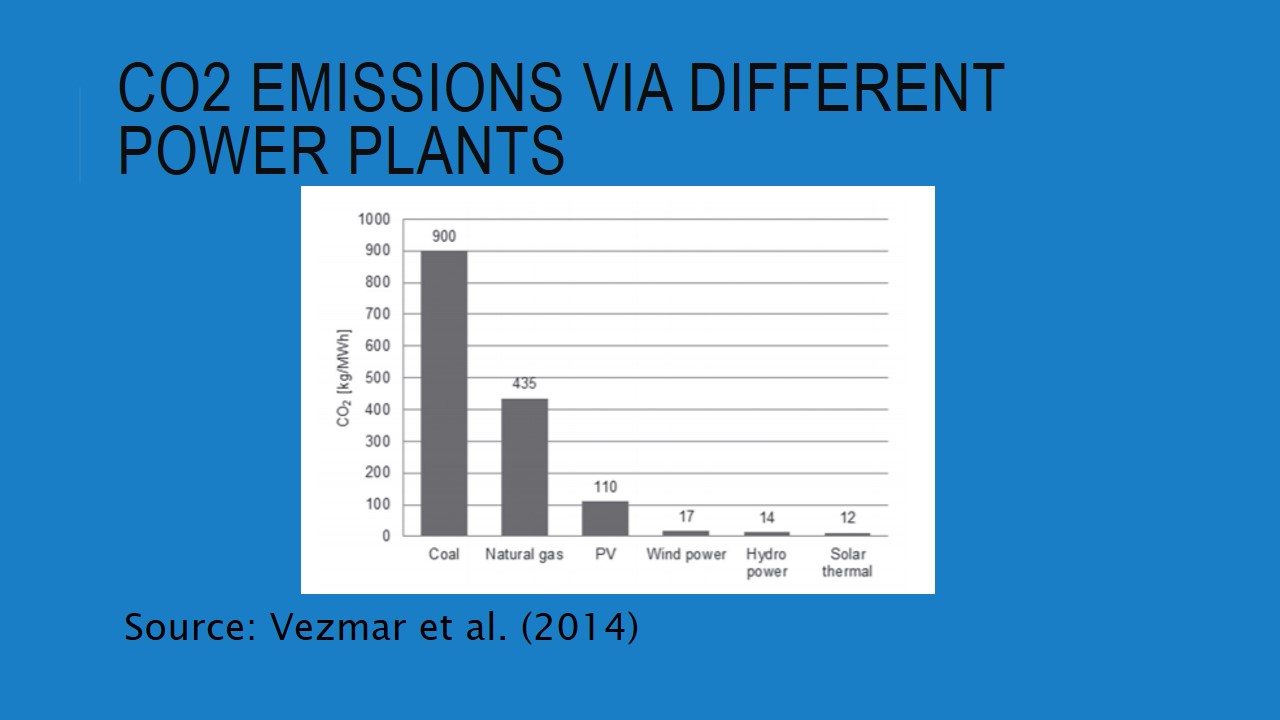
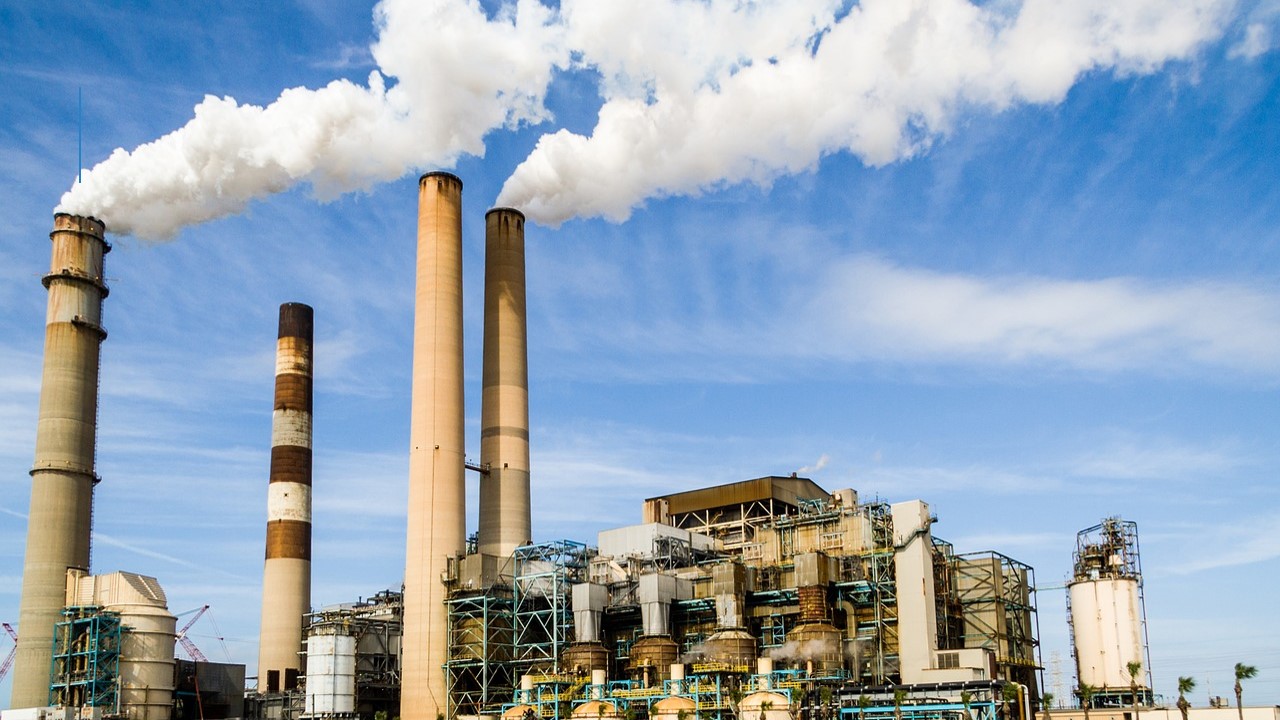
Counterargument
According to Ted Trainer, “although the foregoing figures are not precise or confident, their magnitudes indicate that it will not be possible to meet a 1000 EJ/yr energy target for 2050 from alternative energy sources, within safe greenhouse gas emission levels… . Such a goal could not be achieved without radical change in social, economic, political and cultural systems” (Pyke, 2017, para. 7).
However, taking into account an expected substantial growth in the global population and a consequent energy demand increase, some experts and researchers do not believe that alternative energy will be a good solution. According to an Australian academic and advocate for economic degrowth, Ted Trainer, “it will not be possible to meet a 1000 EJ/yr energy target for 2050 from alternative energy sources, within safe greenhouse gas emission levels” (Pyke, 2017, para. 7). It means that while the global community is oriented towards economic growth and continual improvement of living standards, there will be no way to reduce air pollution and prevent climate change as the population will continue to grow in the future. Moreover, some experts consider that alternative energy alone will not be able to meet the growing energy demand because some sources, such as PV solar energy, are intermittent and their power generation capacity is lower compared to fossil-based plants. Thus, the world will still largely rely on power generated by using non-renewable sources.
It is true that the integration of alternative energy sources in the energy sector is challenging due to multiple factors, including high costs and a relatively low degree of modern technology reliability. Moreover, as Trainer indicated, modern culture and overall economic and political orientations support the aggravation of global warming (Pyke, 2017). However, in case fossil fuels will continue to dominate the market further, the negative impact through energy production and consumption on the environment will be much more severe than if alternative energy will be primarily or solely used.
Although the international community is now aware of the global warming problem, recent statistics indicate that CO2 output from fossil fuels has increased in recent years. The graph provided by Hausfather (2018) shows that annual CO2 emissions from fuels continue to grow nowadays in different regions of the world. It is also clear from the graph that the rate of greenhouse gas emissions has accelerated within the last decade. Moreover, the largest increase in CO2 output of nearly 3% per year has been reported in 2018 (Hausfather, 2018).
It is valid to say that only a faster shift towards alternative energy sources will help to curb the ongoing growth in greenhouse gas emissions and meet the climate change goals under the Paris Agreement. Even though energy demand may substantially increase in the future, it would be much easier to control the present rate of CO2 emissions (based on the current demand level) through power production by using alternative energy sources.
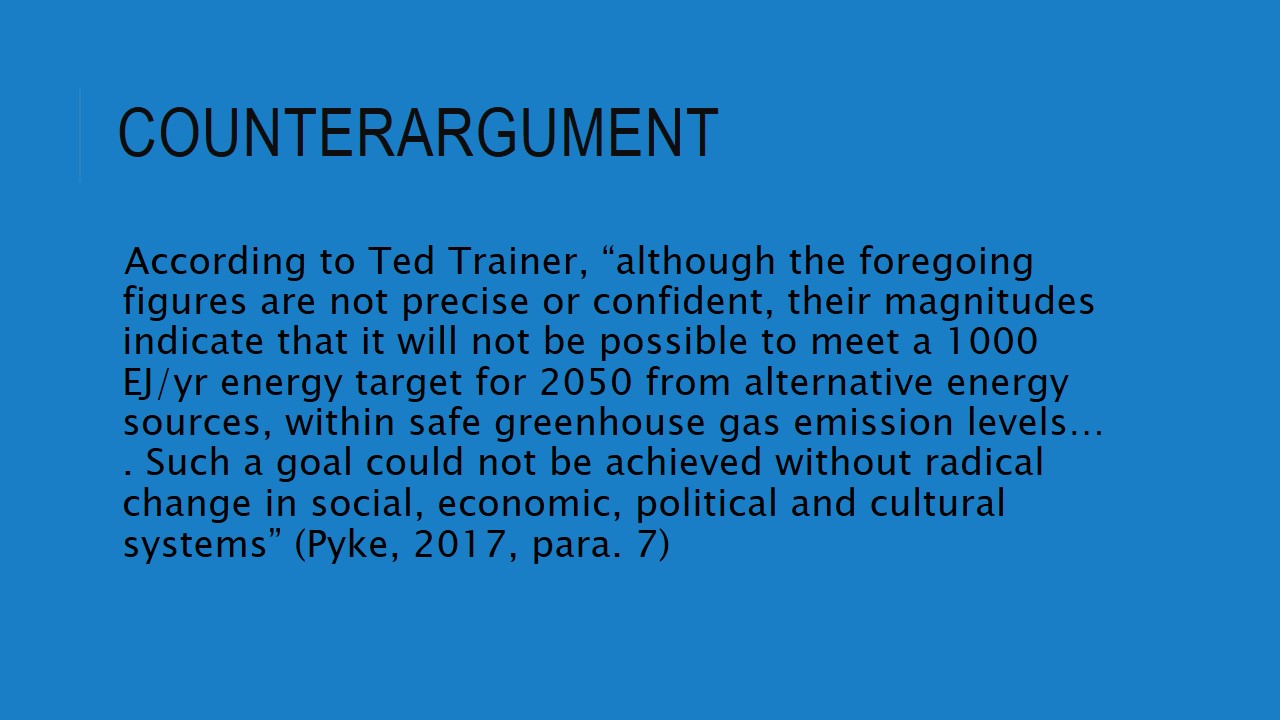
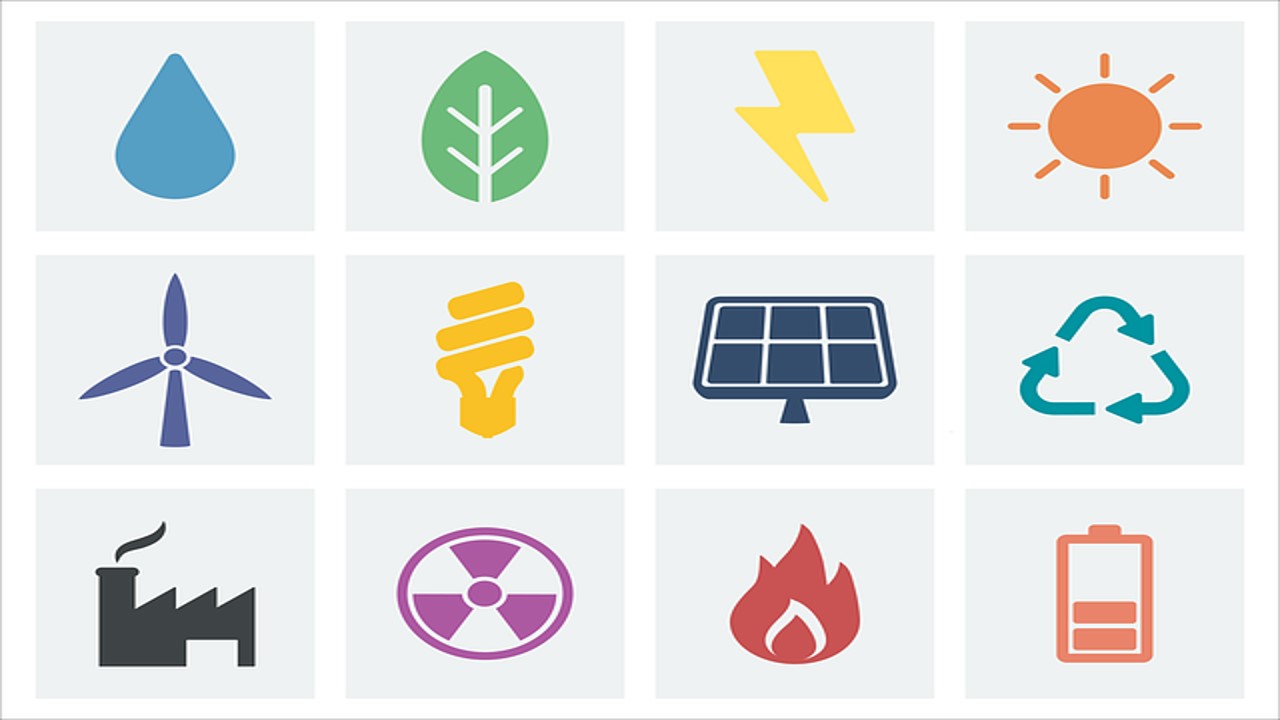
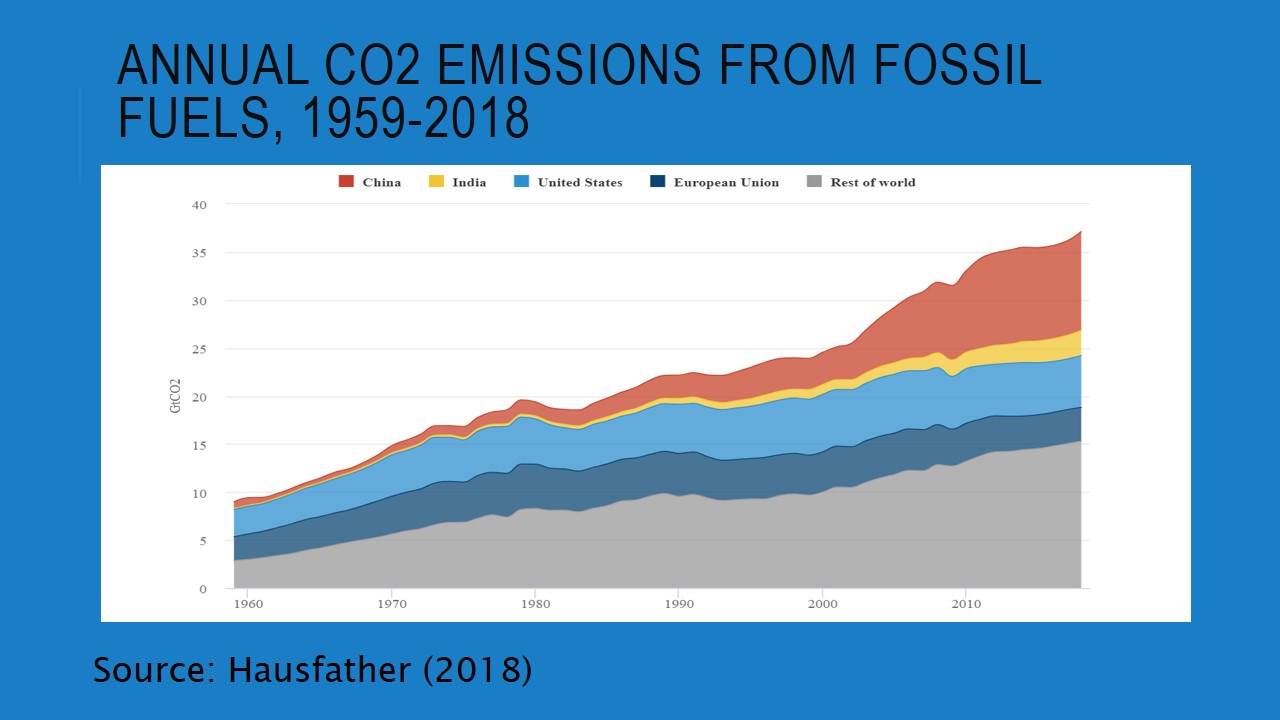

Argument 2: Renewable energy use will help to foster water and soil conservation and improve water quality
Negative impacts of fossil extraction on water and soil quality
- Soil erosion;
- Acid mine drainage;
- Short-term and long-term water and soil contamination through fossil fuel and coal waste;
- Mudslides, landslides, and flashfloods (Ugya, Ajibade & Ajibade 2018; Union of Concerned Scientists, 2016).
Besides air pollution, fossil extraction and burning cause water and soil contamination. For instance, like any type of mining, coal mining causes erosion of exposed soils, whereas acid mine drainage that often occurs at both active and abandoned mining sites can induce long-term contamination of underground and surface waters (Ugya, Ajibade & Ajibade 2018). All these outcomes can negatively impact local communities, threatening individual and public health, as well as biodiversity in the affected areas. Besides that, water utilised in oil and gas extraction becomes polluted with heavy metals and radioactive components, and it is usually extremely difficult to dispose of such toxic water safely (Union of Concerned Scientists, 2016). As a result, the used water can contaminate soil and cannot be suitable for drinking.
Overall, many renewable energy sources may be regarded as much safer in terms of water and air pollution. For example, there is no emission of harmful particles or heavy metals when generating electricity either by using PV, wind or tidal energy systems (Vezmar et al. 2014).
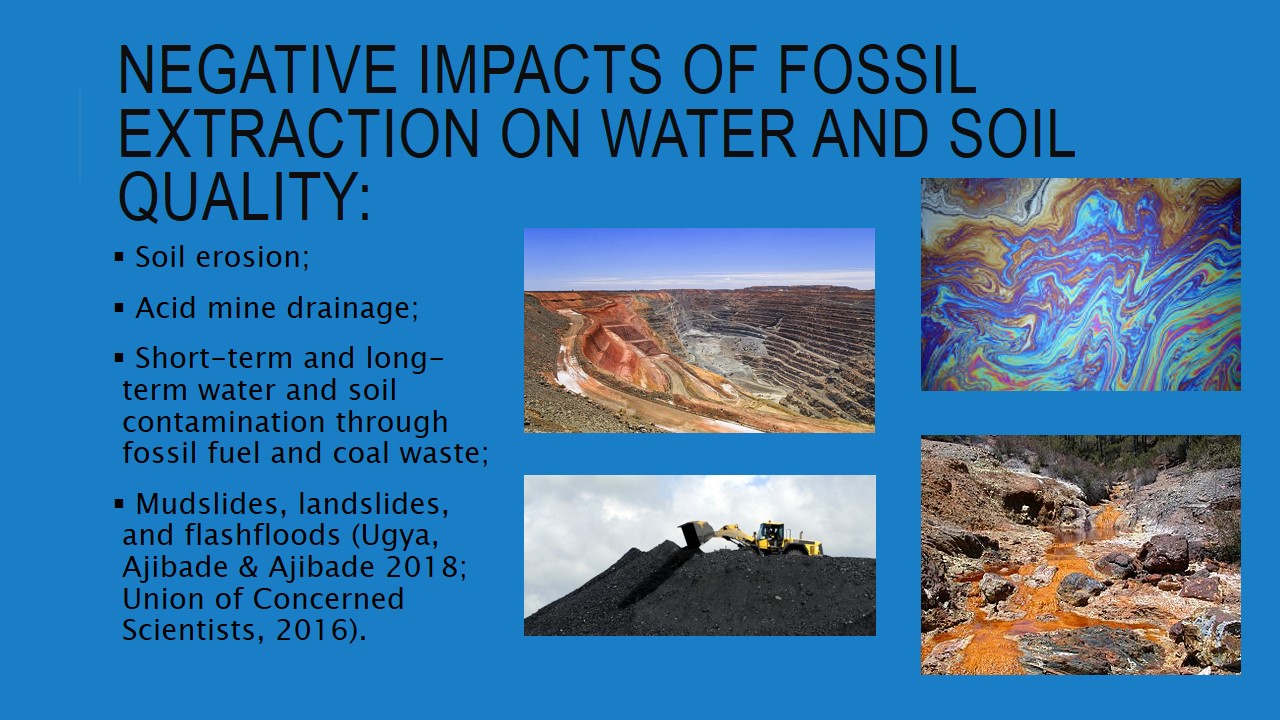
Counterargument
Production of all forms of energy requires the use of water and land and, therefore, negative impacts on aquatic and inland ecosystems cannot be avoided entirely after the shift towards alternative energy sources.
However, as noted by Tripathi et al. (2015), “water is required to produce nearly all forms of energy” and, therefore, almost all activities employing alternative energy sources can negatively affect water quality as well (p. 94). Moreover, alternative energy systems and production of biofuels may occupy substantial portions of land and, thus, impact both aquatic and inland ecosystems.
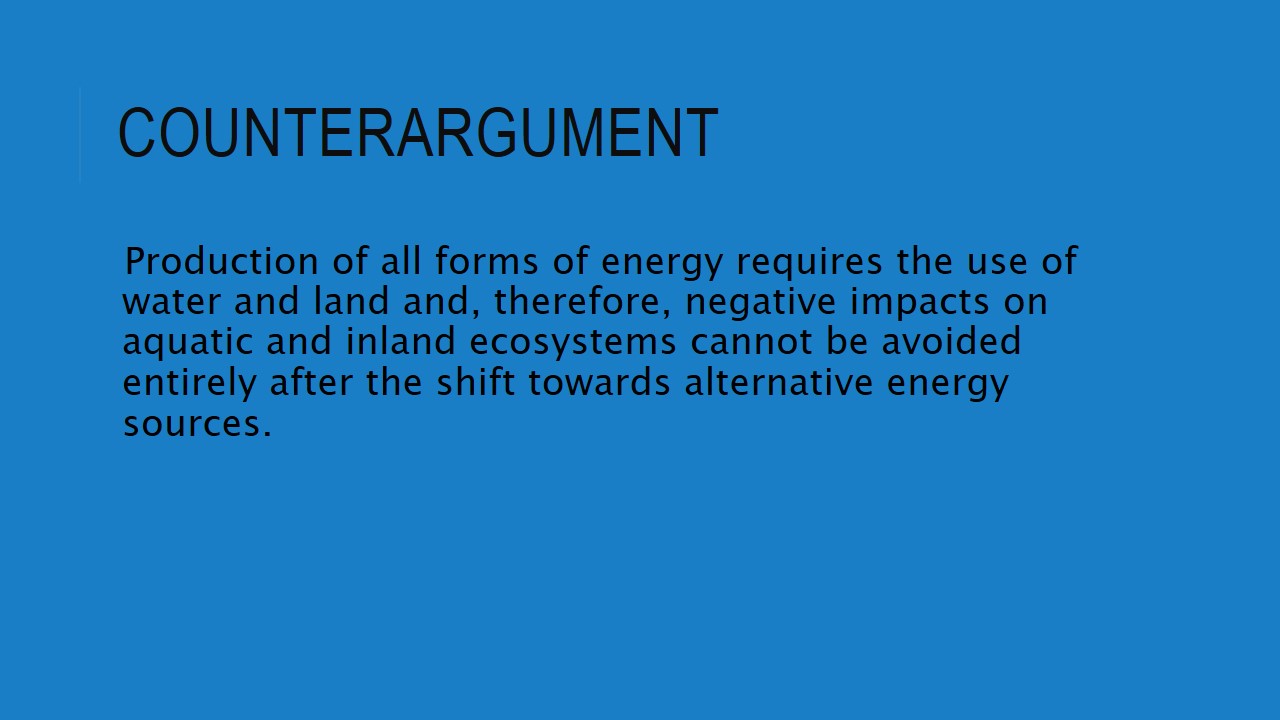
Main uses of water and potential water quality impacts
As the findings summarised in the table by Tripathi et al. (2015) show, the most common among all the potential adverse effects of alternative energy production on water quality include thermal pollution. Noteworthily, biofuel seems to be the most detrimental form of alternative energy. Not only it requires a substantial amount of water for growing crops but also can occupy large land areas. As noted by Pyke (2017), “to provide the anticipated 9 billion people on earth by 2060 we would need 24 billion hectares of biomass plantations” (para. 8). Moreover, similarly to Tripathi et al. (2015), Wu et al. (2018) state that increasing cultivation of bioenergy crops is linked to a high risk of “nutrient pollution resulting from surface runoff and infiltration to groundwater” (p. 3). In this way, biofuel production is associated with both water and soil contamination and loss of natural habitat and biodiversity due to land use changes.
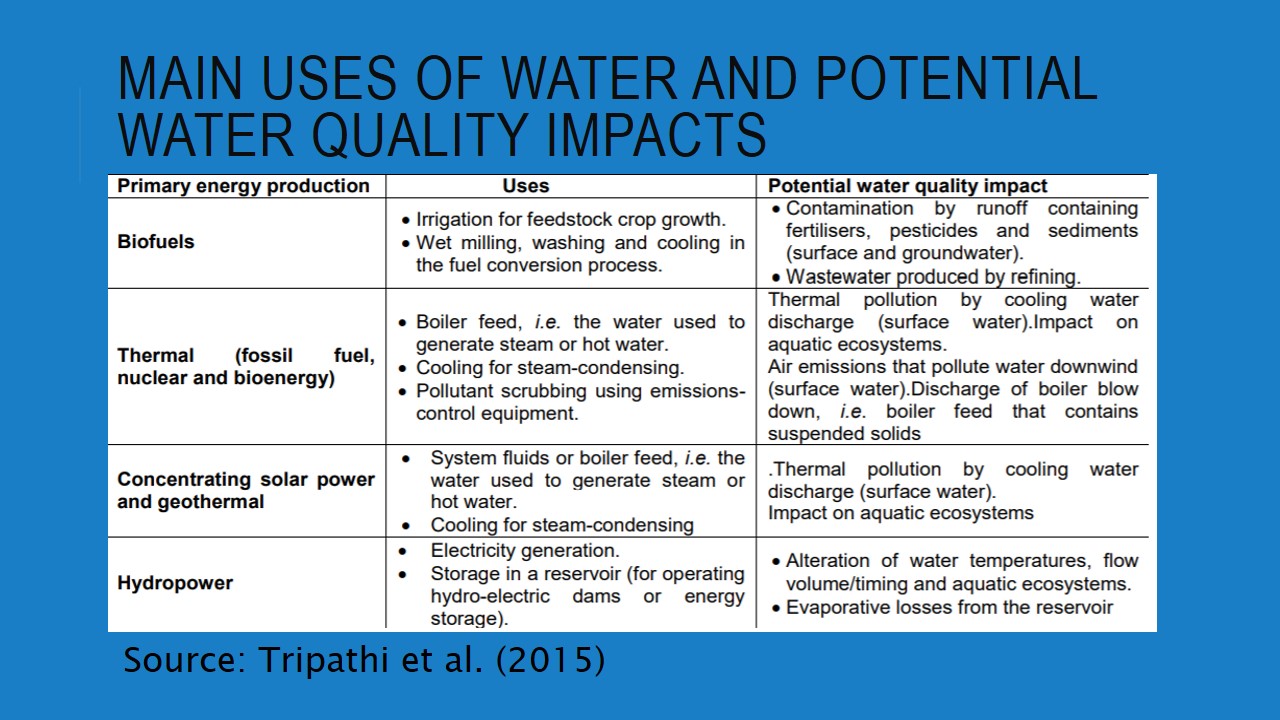
Other potential adverse effects of alternative energy production
- Flooding of the habitat and change of natural water courses by hydropower plants,
- Prevention of free movement of fish by dams,
- Disruption of marine life by wave energy converters,
- Harmful effects on marine ecosystems during the construction of tidal energy plants,
- Threats to bird populations posed by wind turbines (Vezmar et al. 2014).
Other possible negative effects of alternative energy production are summarised in the study by Vezmar et al. (2014) and include flooding of the habitat and change of natural water courses by hydropower plants, prevention of free movement of fish by dams, and some insignificant disruption of marine life by wave energy converters. In addition, the construction of tidal energy plants is associated with harmful effects on marine ecosystems, which, however, may be short-term (Vezmar et al. 2014). Wind turbines also may have negative impacts on bird populations as birds may be injured and killed when flying through blades of turbines (Vezmar et al. 2014).
Considering that energy demand will increase in the future the use of land and water for energy production will rise as well. For instance, as the graph created by Tripathi et al. (2015) shows, the energy sector will experience the greatest growth in water demand by 2050 compared to the majority of other sectors. Thus, it is pivotal to ensure that water is used for energy generation as safely and efficiently as possible.
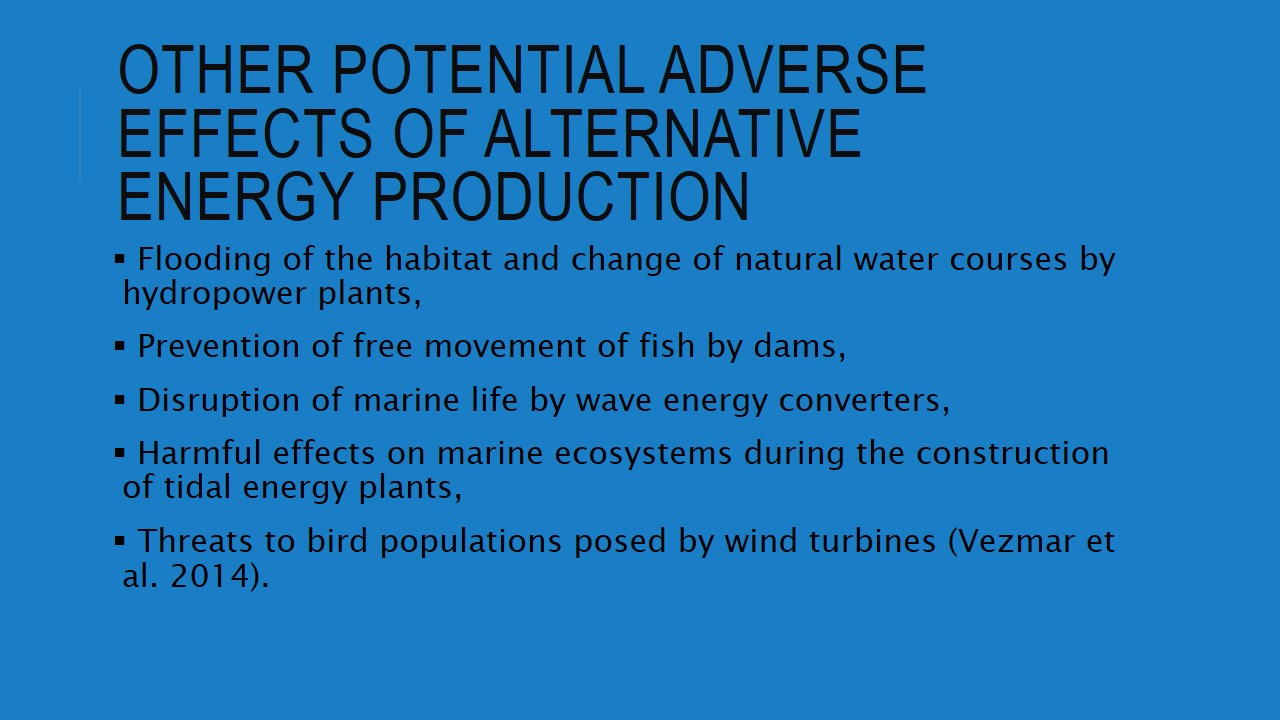
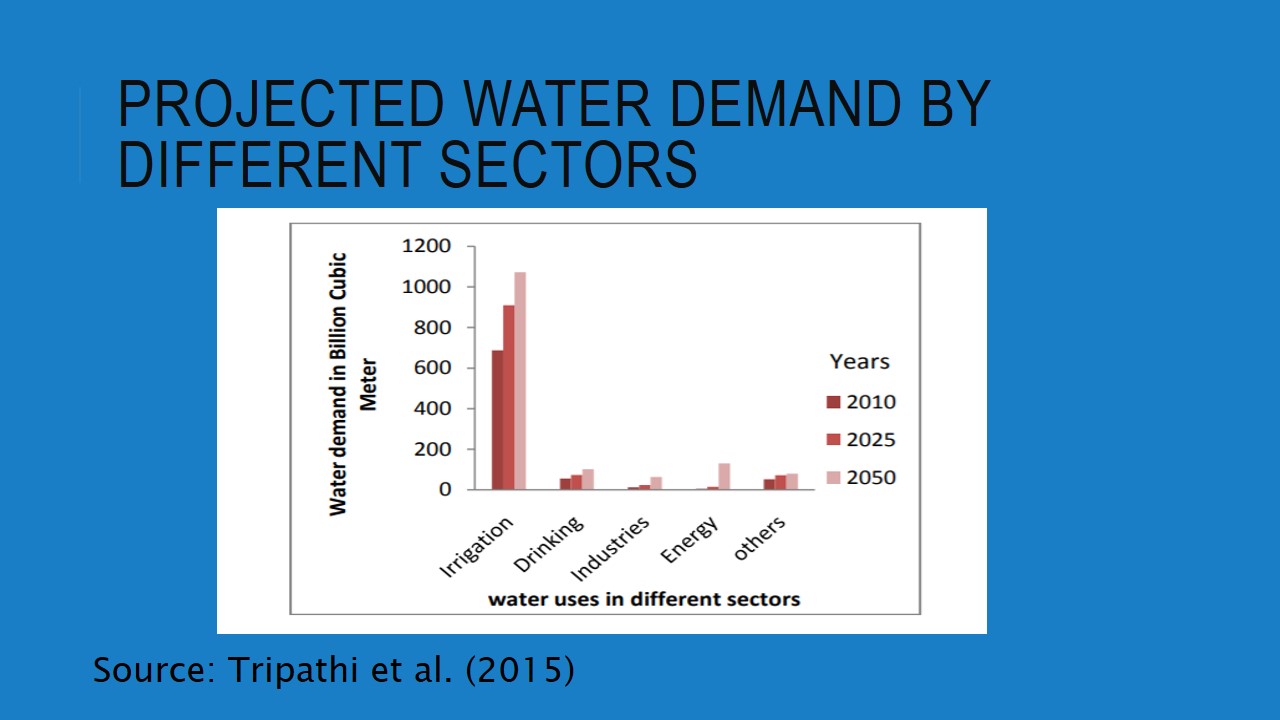
Refutation
- Potential negative effects of alternative energy production on water and soil can be less severe and extensive than adverse impacts caused by fossil extraction and burning.
- Alternative energy use seems to induce more benefits than risks.
- Risks due to alternative energy production can be substantially controlled and prevented through the right strategies (Vezmar et al. 2014).
Despite all of the identified possible negative effects of alternative energy production, it is valid to say that their extent and intensity is less pronounced and severe than in the case of fossil-based power generation. It would be wrong to discard all the significant benefits of renewable energy sources (especially the massive reduction in greenhouse gas emissions) due to comparatively insignificant environmental risks, which, moreover, can be controlled and mitigated by using the right approach. For example, hazards to animal populations resulting from the solar and wind power system operations can be reduced by choosing proper locations for plants (Vezmar et al. 2014). Additionally, to allow free movement of fish, it is possible to construct fish passages in dams (Vezmar et al. 2014).
It seems that risks associated with biomass production are likely the hardest to mitigate. Nevertheless, the knowledge of sustainable crop cultivation practices continues to grow today and can be integrated into the energy sector in the future. Moreover, many nations invest in the research and development of new technologies that may ensure greater water and land use efficiency. Overall, with comprehensive strategic planning and consideration of all environmental risks all forms of alternative energy will be environmentally safe and as reliable as the fossil-based energy nowadays.
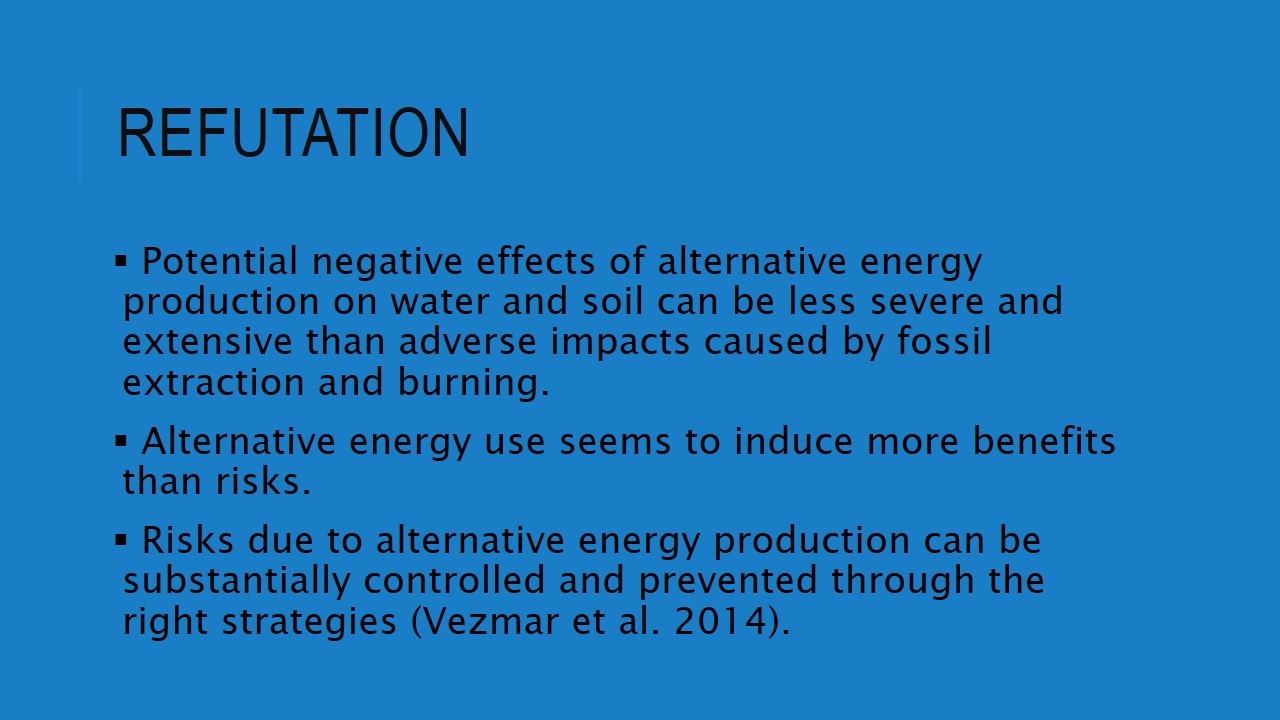
Conclusion
Alternative energy will have a favorable impact on the environment and will allow to control climate change much better than it is currently possible through fossil-based power generation.
Alternative energy will have a favourable impact on the environment and will allow controlling climate change much better than fossil-based power generation. The main reason for this is that renewables are associated with a lower rate of CO2 emissions. Even though alternative power production cannot be absolutely clean and harmless, the environmental hazards caused by it will be less intense.
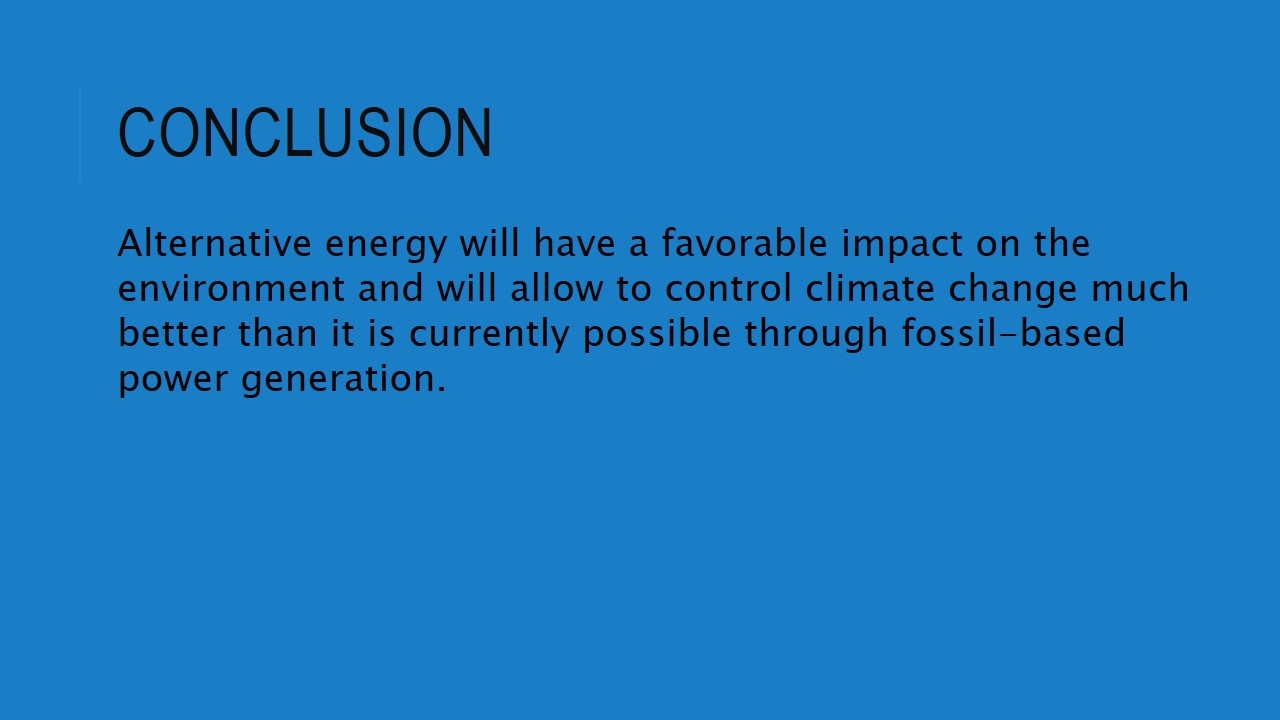
Reference list
Eule, S 2018, A look at IEA’s new global energy forecast. Web.
Hausfather, Z 2018, ‘Analysis: fossil-fuel emissions in 2018 increasing at fastest rate for seven years’, Carbon Brief. Web.
Owusu, PA & Asumadu-Sarkodie, S 2016, ‘A review of renewable energy sources, sustainability issues and climate change mitigation’, Cogent Engineering, vol. 3, no. 1, pp. 1-14.
Pyke, T 2017, ‘The energy debate: renewable energy cannot replace fossil fuels’, Development Education. Web.
Taylor, K n.d., Alternative energy. Web.
Tripathi, L, Mishra, AK, Dubey, AK & Tripathi, CB 2015, ‘Water pollution through energy sector’, International Journal of Technology Enhancements and Emerging Engineering Research, vol. 3, no. 3, pp. 92-96.
Ugya, AY, Ajibade, FO & Ajibade, TF 2018, ‘Water pollution resulting from mining activity: an overview’, in Proceedings of the 2018 Annual Conference of the School of Engineering & Engineering Technology, The Federal University of Technology, Akure, pp. 703-718.
Union of Concerned Scientists 2016, The hidden costs of fossil fuels. Web.
Vezmar, S, Spajić, A, Topić, D, Šljivac, D & Jozsa, L 2014, ‘Positive and negative impacts of renewable energy sources’, International Journal of Electrical and Computer Engineering Systems, vol. 5, no. 2, pp. 15-23.
Wu, Y, Zhao, F, Liu, S, Wang, L, Qiu, L, Alexandrov, G & Jothiprakash, V 2018, ‘Bioenergy production and environmental impacts’, Geoscience Letters, vol. 5, no. 14, pp. 1-9.